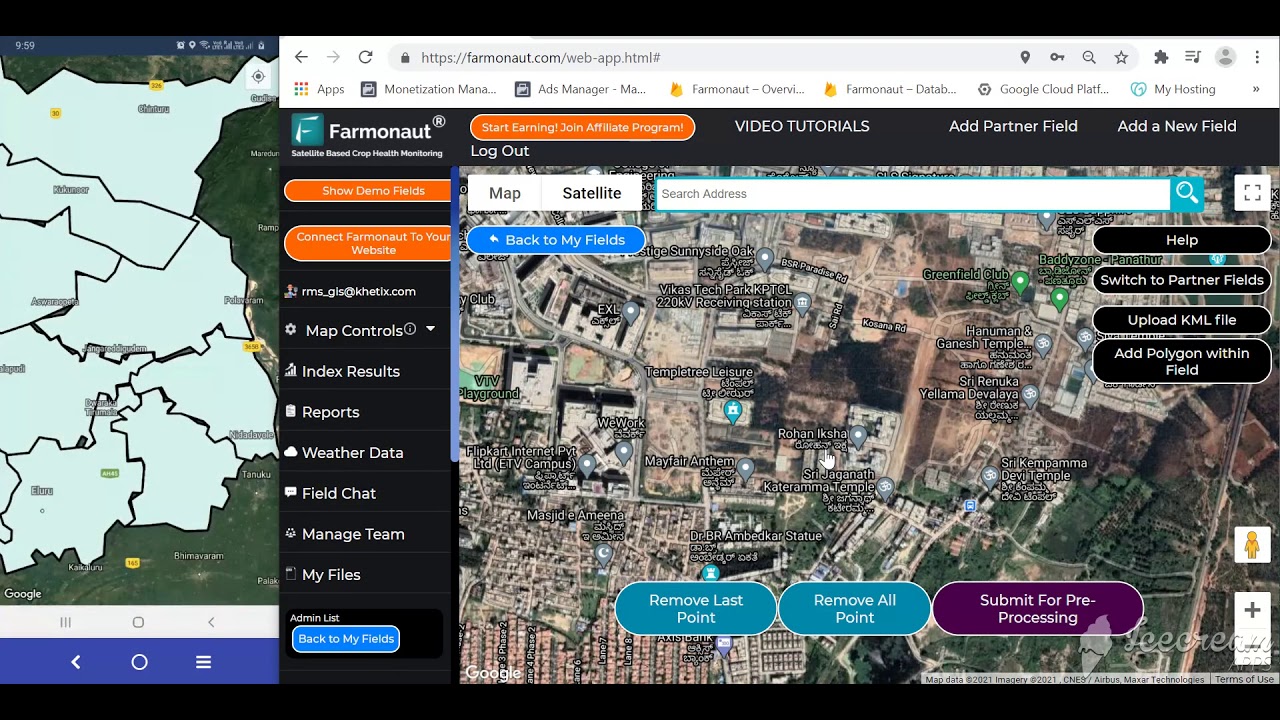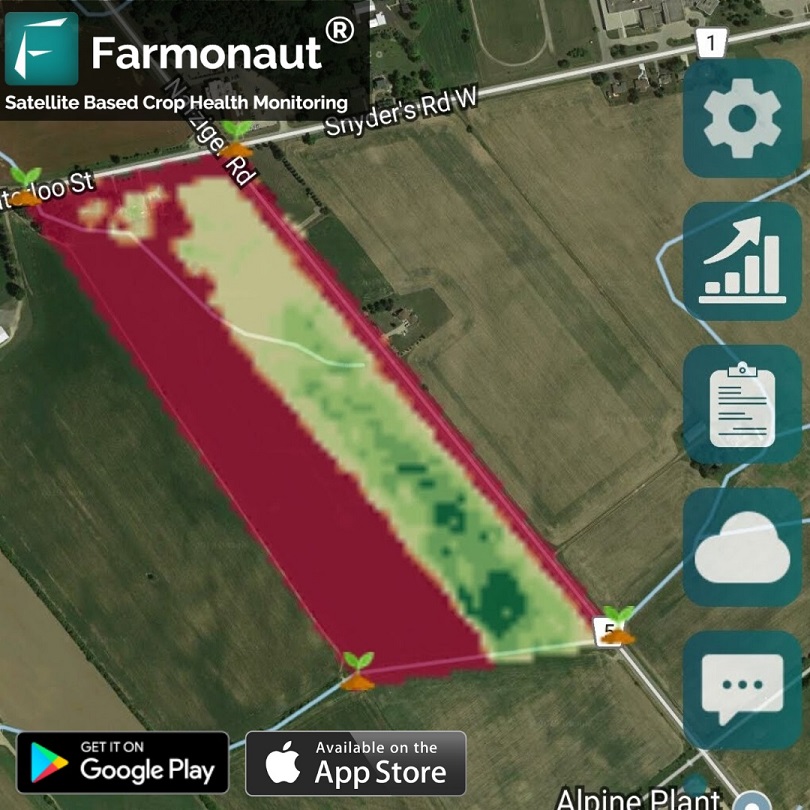Table of Contents
- The Importance of Agricultural Equipment Maintenance
- Key Trivia
- Benefits of Equipment Inspections and Proactive Maintenance
- Best Practices for Farm Equipment Maintenance
- Leveraging Predictive Maintenance & Technology
- Comparative Maintenance Practices Table
- How Farmonaut Boosts Efficiency and Sustainable Farming
- Trivia
- Frequently Asked Questions (FAQ)
Agricultural Equipment Service: Boost Efficiency Fast
In the age of modern farming and forestry, agricultural equipment service and proactive maintenance are no longer optional—they are vital. Whether you’re in planting, irrigation, harvesting, or processing, keeping your machines and equipment in peak condition is essential to increase productivity, safety, and sustain your farm operations amidst competitive landscapes and changing environmental demands.

“Well-maintained farm equipment can increase operational efficiency by up to 25% through predictive maintenance technologies.”
Agricultural machinery enables the backbone of agriculture: efficient planting, irrigation, harvesting, and processing. But without regular maintenance and best practices, even the most advanced equipment risks costly breakdowns and inefficiencies. This comprehensive guide explores agricultural equipment maintenance strategies, farm machinery maintenance tips, and the innovative technologies—like Farmonaut’s satellite platform—helping farmers around the world cultivate higher yields and sustainable operations.
The Importance of Agricultural Equipment Maintenance
Effective agricultural equipment maintenance is the secret behind high yields, operational safety, and enduring sustainability. Let’s explore four central reasons why staying proactive with your maintenance schedule transforms farming and forestry operations:
-
Enhanced Productivity:
Well-maintained machinery operates efficiently, delivering more power with less effort. Fewer breakdowns mean you get more done per day, translating to increased crop yields and profits. (nwkarena.co.za) -
Cost Savings:
Timely maintenance minimizes unexpected breakdowns and major repairs, reducing long-term costs while extending equipment lifespan. (farmersmag.co.za) -
Improved Safety:
Inspecting and servicing machines regularly ensures all safety systems are functioning, creating a safer work environment and reducing injury risk for operators and farm workers. (nwkarena.co.za) -
Environmental Sustainability:
Efficient operation uses less fuel, emits fewer pollutants, and is pivotal for sustainable farming practices. (nwkarena.co.za)
Key Benefits of Equipment Inspections and Proactive Maintenance
Let’s break down exactly what farm machinery maintenance tips and proactive inspections offer:
- Reduces Downtime: Scheduled maintenance detects problems early, ensuring minimal interruption during critical planting or harvesting windows.
- Boosts Equipment Performance: Adequate lubrication, timely part replacements, and sensor diagnostics keep machines running at optimal capacity, maximizing efficiency.
- Promotes Longevity: High-quality parts and proper servicing help withstand harsh field conditions—meaning longer usable life for your machines and greater return on investment.
-
Supports Regulatory Compliance:
Documenting all activities and following a prescribed maintenance schedule for tractors and other machines ensures you’re always audit-ready. -
Upholds Environmental Responsibility:
Efficient machinery means less waste and pollution, central to tracking and reducing carbon footprint.
“Regular machinery servicing reduces unexpected breakdowns by 40%, ensuring safer and more sustainable farming operations.”
Best Practices for Farm Equipment Maintenance
Adopting best practices for farm equipment maintenance amplifies the benefits of inspections and keeps operations running smoothly year-round. Here’s how to create a robust agricultural equipment maintenance plan:
1. Develop a Comprehensive Maintenance Schedule for Tractors & All Major Machines
- Catalog Your Fleet: List machinery, including tractors, combines, planters, irrigation systems, and more.
-
Tailor Schedules:
Assign daily, weekly, monthly, and seasonal maintenance tasks to each equipment type. Include:- Fluid checks & oil changes
- Filter cleaning and replacement
- Inspection of belts, hoses, brakes, and safety devices
- Predictive sensor diagnostics
- Use Digital Tools: A Computerized Maintenance Management System (CMMS) can streamline scheduling, reminders, and record-keeping.
Example: For tractors, include daily checks for tire pressure, oil levels, and safety locks, with more thorough monthly servicing for brakes, air filters, and electrical components.
2. Train Equipment Operators for Safe and Efficient Operation
- Regular Training Sessions: Ensure new and veteran operators are versed in latest equipment operation, troubleshooting, and maintenance procedures.
- Hands-On Education: Routine hands-on demonstrations reinforce the importance of inspections, safe handling, and operating efficiencies.
- Promote Proactive Detection: Proper training helps operators spot minor issues early—before they evolve into significant failures.
3. Invest in High-Quality Parts and Lubricants
- Withstand Harsh Conditions: High-quality lubricants, filters, and replacement components are designed for rugged field operations, minimizing breakdowns.
- Reduce Long-Term Costs: Though premium parts may cost more upfront, they pay off through increased longevity and fewer failures.
- See why quality parts matter for agricultural machinery
4. Document Maintenance Activities and Inspections
- Maintain Detailed Records: Log dates, services performed, parts replaced, and observations for every maintenance activity.
- Enhance Traceability: Thorough documentation helps with warranty compliance, safety audits, and optimizes future maintenance planning.
- Farmonaut’s blockchain-based product traceability tools can help large organizations transparently record resource use and equipment servicing, ensuring supply chain integrity.
5. Schedule Timely Lubrication and Part Replacements
- Prevent Excessive Wear: Oil, grease, and hydraulic fluid levels should be checked and refilled regularly. Follow manufacturer guidelines for replacement intervals.
- Use Predictive Tools: Deploy sensors to monitor temperature, vibrational anomalies, and wear—a cornerstone of predictive maintenance in agriculture.
6. Embrace Digital and Mobile Tools for Resource Management
-
Fleet Management:
Modern digital platforms track equipment movements, optimize usage, and enable predictive scheduling to reduce farm equipment downtime. For advanced multi-equipment and resource tracking, check out our Fleet Management solution. -
API Integrations:
For agribusinesses and software developers wishing to harness real-time weather and satellite data for maintenance optimization, our API and Developer Documentation are available.

Leveraging Predictive Maintenance and Technology in Agriculture
Technology is transforming agricultural equipment maintenance. Farms adopting digital tools, sensors, and artificial intelligence (AI) realize major reductions in cost, downtime, and environmental impact. Here’s how:
Predictive Maintenance in Agriculture: The Future of Sustainable Operations
- Internet of Things (IoT) Sensors: Modern agricultural equipment can be outfitted with IoT sensors that monitor temperature, vibrations, engine health, and fluid levels.
- Data Analytics for Proactive Repairs: Analysis of streaming sensor data identifies unusual patterns—predicting breakdowns before they cause costly delays.
- Remote Monitoring & Alerts: Mobile and web platforms notify operators about maintenance needs in real time, even across vast plantations or difficult terrain.
- Resource Optimization: By targeting maintenance only where needed, predictive tools minimize labor and part costs while keeping machinery in peak condition.
For a deep dive into predictive maintenance, see how predictive maintenance maximizes equipment longevity.
Precision Agriculture Tools: GPS and Satellite Innovations
- Precision Monitoring: GPS and satellite systems, such as those offered by our Farmonaut platform, monitor crop and machinery performance—for timely decisions and target resource allocation.
- Remote Inspections & Soil Health: Multispectral satellite imagery detects moisture stress or crop vigor issues linked to inefficient machinery or irrigation, alerting you to act fast.
- Regulatory Data Compliance: Satellite-based records keep your operation compliant with sustainability standards and insurance verifications, minimizing administrative effort.
- Explore more on precision agriculture technology.
Comparative Maintenance Practices Table
The following table clearly summarizes some of the most impactful maintenance activities, focusing on the service, predictive maintenance, performance, and sustainable impacts across key farm machinery.
| Equipment Type | Maintenance Activity | Estimated Frequency (per year) |
Efficiency Gain (%) |
Estimated Cost Savings ($) |
Sustainability Rating |
|---|---|---|---|---|---|
| Tractor | Engine oil & filter change | 6 | 12 | 350 | ⭐⭐⭐⭐⭐ |
| Combine Harvester | Belt inspection & adjustment | 12 | 10 | 300 | ⭐⭐⭐⭐ |
| Sprayer | Nozzle cleaning/replacement | 24 | 8 | 180 | ⭐⭐⭐⭐⭐ |
| Planter | Row unit sensor calibration | 2 | 15 | 260 | ⭐⭐⭐⭐ |
| Irrigation System | Pump/Aggregate Predictive Sensor Diagnostics | 4 | 18 | 400 | ⭐⭐⭐⭐⭐ |
| All Mobile Equipment | Tire pressure & tread check | 18 | 7 | 140 | ⭐⭐⭐⭐⭐ |
| Forestry Machines | Hydraulic fluid analysis | 3 | 13 | 340 | ⭐⭐⭐⭐ |
Note: Values are estimates and can vary by manufacturer, model age, and operational intensity. Frequency can be increased for harsh working conditions or intensive seasonal use.
How Farmonaut Boosts Efficiency and Sustainable Farming
At Farmonaut, we believe every farmer and agribusiness deserves access to world-class data, affordable technology, and the tools to unlock long-term sustainability. That’s why our platform leverages satellite imagery, artificial intelligence (AI), and blockchain to optimize farm management and agricultural equipment service globally.
-
Satellite Crop Monitoring:
We use real-time multi-spectral imagery to monitor crop health, soil moisture, and field conditions—helping you schedule maintenance and allocate equipment when it’s needed most. -
AI Advisory with Jeevn:
Our AI-driven Jeevn system delivers actionable insights and weather forecasts—improving farm equipment performance, planting/harvesting timing, and resource plans. -
Blockchain Traceability:
Supply chain trust is secured by our traceability tools, ensuring each part and component’s journey is visible—especially valuable for those complying with environmental or consumer standards. -
Resource & Fleet Management:
From monitoring vehicles to tracking usage trends, our tools let farms and agribusinesses minimize downtime, analyze costs, and optimize schedules. Discover how our Fleet Management reduces operational costs. -
Carbon Footprinting & Sustainability:
With our carbon tracking tools, farms can monitor and reduce emissions, making every operation more climate-friendly and compliant with global standards. Start your carbon footprint measurement here. -
Accessible from Any Device:
Our solutions are available across Android, iOS, and browser/web—designed to work for everyone, everywhere, with flexible subscriptions for all scales. -
Crop Loan & Insurance Verification:
For financial institutions needing credible and independent farm verification, we offer satellite-enabled reports for insurance and crop loan risk assessment:
Explore Crop Loan and Insurance Solutions
Frequently Asked Questions (FAQ)
What is agricultural equipment maintenance?
Agricultural equipment maintenance is the systematic approach to inspecting, servicing, and repairing farm machinery to maximize efficiency, prevent breakdowns, and prolong operational lifespan. It covers everything from daily fluid checks to advanced predictive diagnostics.
What is the best maintenance schedule for tractors?
A strong maintenance schedule for tractors should include daily checks of oil, coolant, and hydraulic fluids, weekly inspection of brakes and belts, monthly lubrication, and seasonal deep servicing. Integrate digital reminders or CMMS software for consistency.
How does predictive maintenance in agriculture work?
Predictive maintenance uses sensors and analytics to assess machinery health in real-time. Algorithms detect conditions that indicate impending failures, providing alerts for proactive repairs and minimizing equipment downtime.
What are the environmental benefits of regular equipment servicing?
Regular servicing reduces fuel consumption and greenhouse gas emissions by ensuring efficient engine function, thus supporting sustainable farming practices and environmental conservation efforts.
Which Farmonaut tools help with equipment and fleet management?
Our fleet management module assists in tracking vehicle and machinery usage, optimizing maintenance schedules, and minimizing downtime. Learn more at our Fleet Management page.
How can small and medium farms benefit from satellite-based solutions?
By leveraging Farmonaut’s real-time satellite imagery and AI advice, smallholders can monitor crop health, manage resources better, and anticipate machinery servicing, all through affordable and accessible mobile/web platforms.
Are there digital resources for agricultural maintenance automation?
Absolutely! Farmonaut provides APIs and mobile/web apps for automating equipment records, setting reminders, and integrating with other digital farm management tools. Check our API and developer docs for more.
How can maintenance records improve compliance and traceability?
Detailed service logs ensure regulatory readiness and enable transparent traceability in the supply chain, which is simple and secure with our blockchain-based solutions.
Where can I get the Farmonaut App?
Conclusion
By adopting proactive agricultural equipment maintenance—from daily inspections and scheduled lubrication to advanced predictive sensor solutions—farmers and forestry operators can enjoy enhanced productivity, reduced operating costs, and greater yields. Embracing best practices and leveraging innovative platforms like Farmonaut drives not only immediate gains, but sustainable, environmentally-friendly growth for years to come.
Prioritize best practices, embrace digital transformation, and stay ahead with the latest technology to secure the future of your farm or agribusiness. Ready to enrich your operation and begin your journey towards sustainable farming practices?
Discover Farmonaut’s precision agriculture and resource management solutions.
Start for free now




















